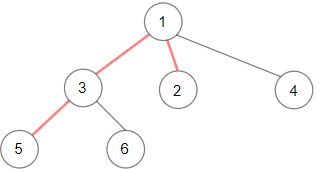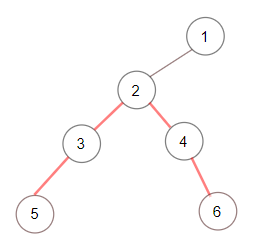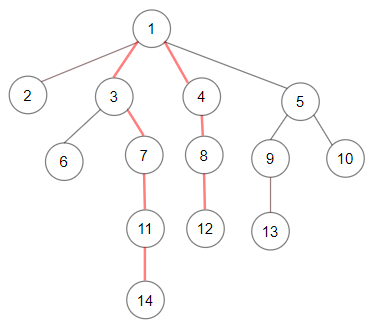Welcome to Subscribe On Youtube
1522. Diameter of N-Ary Tree
Description
Given a root of an N-ary tree, you need to compute the length of the diameter of the tree.
The diameter of an N-ary tree is the length of the longest path between any two nodes in the tree. This path may or may not pass through the root.
(Nary-Tree input serialization is represented in their level order traversal, each group of children is separated by the null value.)
Example 1:

Input: root = [1,null,3,2,4,null,5,6] Output: 3 Explanation: Diameter is shown in red color.
Example 2:

Input: root = [1,null,2,null,3,4,null,5,null,6] Output: 4
Example 3:

Input: root = [1,null,2,3,4,5,null,null,6,7,null,8,null,9,10,null,null,11,null,12,null,13,null,null,14] Output: 7
Constraints:
- The depth of the n-ary tree is less than or equal to
1000. - The total number of nodes is between
[1, 104].
Solutions
-
/* // Definition for a Node. class Node { public int val; public List<Node> children; public Node() { children = new ArrayList<Node>(); } public Node(int _val) { val = _val; children = new ArrayList<Node>(); } public Node(int _val,ArrayList<Node> _children) { val = _val; children = _children; } }; */ class Solution { private int ans; public int diameter(Node root) { ans = 0; dfs(root); return ans; } private int dfs(Node root) { if (root == null) { return 0; } int m1 = 0, m2 = 0; for (Node child : root.children) { int t = dfs(child); if (t > m1) { m2 = m1; m1 = t; } else if (t > m2) { m2 = t; } } ans = Math.max(ans, m1 + m2); return 1 + m1; } } -
/* // Definition for a Node. class Node { public: int val; vector<Node*> children; Node() {} Node(int _val) { val = _val; } Node(int _val, vector<Node*> _children) { val = _val; children = _children; } }; */ class Solution { public: int ans; int diameter(Node* root) { ans = 0; dfs(root); return ans; } int dfs(Node* root) { if (!root) return 0; int m1 = 0, m2 = 0; for (Node* child : root->children) { int t = dfs(child); if (t > m1) { m2 = m1; m1 = t; } else if (t > m2) m2 = t; } ans = max(ans, m1 + m2); return 1 + m1; } }; -
""" # Definition for a Node. class Node: def __init__(self, val=None, children=None): self.val = val self.children = children if children is not None else [] """ class Solution: def diameter(self, root: 'Node') -> int: """ :type root: 'Node' :rtype: int """ def dfs(root): if root is None: return 0 nonlocal ans m1 = m2 = 0 for child in root.children: t = dfs(child) if t > m1: m2, m1 = m1, t elif t > m2: m2 = t ans = max(ans, m1 + m2) return 1 + m1 ans = 0 dfs(root) return ans -
/** * Definition for a Node. * type Node struct { * Val int * Children []*Node * } */ func diameter(root *Node) int { ans := 0 var dfs func(root *Node) int dfs = func(root *Node) int { if root == nil { return 0 } m1, m2 := 0, 0 for _, child := range root.Children { t := dfs(child) if t > m1 { m2, m1 = m1, t } else if t > m2 { m2 = t } } ans = max(ans, m1+m2) return 1 + m1 } dfs(root) return ans }